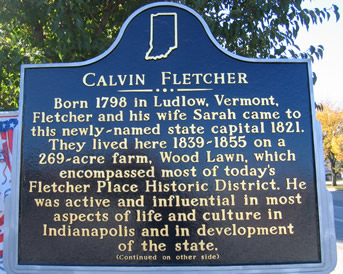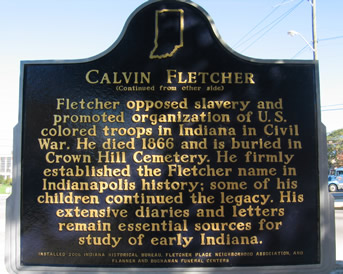

Location: Virginia Avenue and East Street, Indianapolis. (Marion County, Indiana)
Installed: 2006 Indiana Historical Bureau, Fletcher Place Neighborhood Association, and Flanner and Buchanan Funeral Centers
ID# : 49.2006.1
This marker was damaged and replaced by Marker ID#: 49.2023.7 Calvin Fletcher (1798-1866)
Text
Side one:
Born 1798 in Ludlow, Vermont, Fletcher and his wife Sarah came to this newly-named state capital 1821. They lived here 1839-1855 on a 269-acre farm, Wood Lawn, which encompassed most of today's Fletcher Place Historic District. He was active and influential in most aspects of life and culture in Indianapolis and in development of the state.
Side two:
Fletcher opposed slavery and promoted organization of U.S. colored troops in Indiana in Civil War. He died 1866 and is buried in Crown Hill Cemetery. He firmly established the Fletcher name in Indianapolis history; some of his children continued the legacy. His extensive diaries and letters remain essential sources for study of early Indiana.
Annotated Text
Born 1798 in Ludlow, Vermont, (1) Fletcher and his wife Sarah came to this newly-named state capital 1821.(2) They lived here 1839-1855 on a 269-acre farm, Wood Lawn, (3) which encompassed most of today's Fletcher Place Historic District.(4) He was active and influential in most aspects of life and culture in Indianapolis and in development of the state.(5)
Fletcher opposed slavery(6) and promoted organization of U.S. colored troops in Indiana in Civil War.(7) He died 1866 and is buried in Crown Hill Cemetery.(8) He firmly established the Fletcher name in Indianapolis history; some of his children continued the legacy.(9) His extensive diaries and letters remain essential sources for study of early Indiana.(10)
Notes:
1. Indianapolis Daily Journal, May 28, 1866; The Diary of Calvin Fletcher (Indianapolis, 1972-1983), 1:xxxi (hereafter Diary).
2. Diary, 1:xxxii, 38, 41, 42.
3. Diary, 1:286 Fletcher says the farm was 264 acres; 286 note, cites Marion County deed records and Indianapolis Indiana Democrat December 8, 1835 indicating the farm was 269 acres. Ibid., 2:xvi, 123, 129 (entry for January 1, 1840 Fletcher indicates the farm was 262 acres), 129 note; 5:xxxvi.
4. Indianapolis Historic Preservation Commission, Historic Area Preservation Plan 13 – Fletcher Place (Indianapolis, 1980), [8]; Diary, 1:286 note, 2:129 note. Fletcher Place Historic District, 1855-1924 was listed in the National Register of Historic Places in 1982. It is bounded by I-65/I-70, Penn Central railroad tracks, East Street, and Virginia Avenue. Historic Indiana, Indiana Properties Listed in the National Register of Historic Places, 2003-2004 (Department of Natural Resources, Division of Historic Preservation), 31.
5. Diary, 1:xii-xiv.
6.Diary, 2:332.
7.Fletcher promoted organization of colored troops to fight for the Union as early as 1862-1863. Diary, 7:xxxii (1862), 8:xxi (1863), 192, 267, 269.
As indicated on the Indiana Historical Marker for "28th Regiment USCT, " land in current Fletcher Place belonging to Calvin Fletcher was used for training colored troops in the Civil War; it was known as Camp Fremont. According to Emma Lou Thornbrough, The Negro in Indiana: A Study of a Minority Indianapolis, 1957), 201, "Men of the 28th assembled and received preliminary training at Camp Fremont . . . between December 1863 and April 1864. According to an item in the Christian Recorder, February 13, 1864. "The New Year finds us . . . . The First Indiana Colored Battalion . . . encamped on Mr Calvin Fletcher's farm . . . called Camp Fremont."
Letter, Adjutant General's Office, War Department to Governor O.P. Morton, January 12th 1864, Indiana State Archives, states that "the regiment of colored troops . . . will be known . . . as the 28th Regiment USCT." The 28th Regiment U.S. Colored Troops was not organized until April 1864. According to W. H. H. Terrell, Indiana in the War of the Rebellion: Report of the Adjutant General, Vol. 3 (Indianapolis, 1869), 382-83, "Six companies were organized at Indianapolis in April 1864 and turned over to U.S. as a battalion of the 28th U.S. Colored Infantry."
8.Diary, 9:xxi, 264; Indianapolis Daily Journal, May 28, 1866; Burial Locator, Crown Hill Cemetery, (www.crownhill.org/genealogy/index.html), accessed October 28, 2004.
9.Diary, 3:442-44, 9:265-76.
10.George Geib, "The Diary of Calvin Fletcher and the Historians, " Traces of Midwestern History, Winter 1998, p. 23.
Keywords
Historic District, Neighborhoods, and Towns, African American, Military
